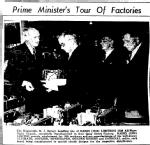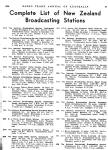
Information / Radiohistory for New Zealand-Aotearoa

Government monopoly
The first official mention of radio in New Zealand is a 17 October 1902 notification to mariners of a list of stations established by the Marconi Wireless Telegraph Company, albeit there were none in the southern hemisphere, let alone New Zealand. Nevertheless the New Zealand Government was reputedly first in the world to take control of the use of the new technology by way of the New Zealand Wireless Telegraphy Act 1903. In essence only the Government was permitted to receive and transmit wireless communications and anyone else who did so without permission was liable to a £500 fine and confiscation of equipment. As Albert Pitt, the Attorney-General, stated to Parliament at the time
"The whole principle of the Bill is that the Government intend to acquire a monopoly of this system in the colony".
One of the main concerns, as outlined by the Postmaster-General of the day, was that the new wireless telegraphy technology might render the wired telegraphy network obsolete and thereby deprive the Government of revenue. The first public demonstration of radio in New Zealand was given by the Marconi Company at the 1906 Christchurch International Exhibition. The military and maritime potential of radio was spurred by the Radio-telegraph Convention signed at Berlin on 3 November 1906, which the New Zealand Government ratified the following year. The first message by wireless from New Zealand to another country was sent on 3 February 1908 from Sir Joseph Ward on board the HMS Pioneer berthed at Wellington. The message was relayed by the HMS Powerful in the Tasman Sea to the HMS Psyche berthed at Sydney.
In 1909 an Australasian Telegraph Conference was held in Melbourne and this led to a New Zealand Government decision to establish a number of marine radio coast stations at Auckland (ZLD), Wellington (ZLW) and the Chatham Islands (ZLC)5.
The first station, a 2.5 kilowatt 'spark' transmitter, opened on 26 July 1911 and operated from a tower at the General Post Office in Wellington. In October of that year the station was transferred to Mount Etako (also known as Mt Wakefield and latterly as Tinakori Hill) where it provided a wireless telegraph service to ships within a 600 mile radius. Two high-power stations with a range of 1250 miles were also planned, one at Awanui (ZLA) in the north and the other at Awarua (ZLB) near Bluff8.
The frequency of early radio transmitters and receivers was not able to be controlled to any significant degree, thus only one wireless communication at a time could take place in any given geographical area. With the tragic circumstances surrounding the loss of the Titanic in 1912, it was realised that a management framework for radio transmission and reception was necessary to ensure the potential of the technology could be realised. Although the upper range of frequencies suitable for wireless communication was unknown, the concept gradually emerged of the radio spectrum10 as a public and economic resource, and licensing (the generation of radio waves) as a management tool for the prevention of radio interference.
Government regulation of the transmission of radio waves thus had a two-fold purpose – to protect Government revenue (by ensuring there was a Government monopoly on telecommunications), and to organise and allocate frequencies to prevent interference. While the first objective disappeared with the progressive deregulation of New Zealand telecommunications in the 1980's, spectrum management, albeit within a market allocation framework since 1990, has become increasingly important in maximising the societal benefits and commercial opportunities of radio communication technologies.
Development of broadcasting
By 1907 the work of two men, John Fleming and Lee De Forest, had resulted in the development of a device to amplify and detect weak electrical signals - the vacuum tube (or valve as it was also known). This laid the foundation for radio-telephony and De Forest was quick to see the opportunities. His diary records the following comments;
"My present task is to distribute sweet melody broadcast over the city and sea …… someday the news and even advertising will be sent out over the wireless telephone".
Both radio telegraphy and radio telephony were used during World War I, but the military were slow to relinquish their hold on it for civilian applications. Even home construction of radio receivers was made difficult because valves were not freely available. It wasn't until the Post and Telegraph Amendment Act of 1920 that provision was made to licence receivers independent of transmitters, and this set the scene for broadcasting as we know it.
In 1921 a Wellington businessman, Charles Forrest, began transmitting gramophone recordings from a room in the Hope Gibbons building. Although he had no formal permit or licence he had a verbal understanding with the Chief Telegraph Engineer such that whenever his transmissions were causing reception problems at the nearby marine radio station, he would cease until the ship-to-shore communication was concluded. Professor Robert Jack of Otago University became the first licensed broadcaster when, on 17 November 1921, he transmitted the first of a series of concerts that included live music and gramophone recordings. His transmissions were heard as far afield as Auckland.
In July 1922 a radio station commenced, in Wellington, which was licensed to operate on a wavelength of 275 metres (~1000 kHz). The operators were even invited by the P & T to broadcast the 1922 election results. In 1923 the Government decided to promote private broadcasting and regulations were introduced which divided the country into regions, specified frequencies and transmitters powers, but banned advertising. The first station licensed under the new regulations was 1YA in Auckland (pictured). A licence, costing 5 shillings, was required to receive broadcast transmissions, and applicants had to supply a character reference and proof of British nationality.
Space does not permit a history of broadcasting in New Zealand, suffice to say that private broadcast stations (known as the 'B stations') flourished during the 1920's and 1930's. However the Broadcasting Act 1936 established state broadcasting under a new Government department, the National Broadcasting Service (NBS) and by the beginning of World War II all but two of the private stations had been purchased by the Government. Radio, and eventually television, broadcasting was largely to be the preserve of the Government for many years to come.
From: Radio Spectrum Management, a business unit of the Ministry of Business, Government of New Zealand, “Radiocommunications History in New Zealand pdf”.
|
Hits: 1396 Replies: 0
Complete List of Broadcasting New Zealand Stations 1937
|
|||||||||||||||||||||||||||||||||||||||||||||||||||||||||||||||||||||||||||||||||||||||||||||||||||||||||||||||||||||||||||||||||||||||||||||||||||||||||||||||||||
|
Gary Cowans
21.Oct.21 |
1
1938 RADIO TRADE ANNUAL OF AUSTRAL1A Complete List of Broadcasting New Zealand Stations 1937 1938 Radio Trade Annual of Australia, page 85.
|
||||||||||||||||||||||||||||||||||||||||||||||||||||||||||||||||||||||||||||||||||||||||||||||||||||||||||||||||||||||||||||||||||||||||||||||||||||||||||||||||||
|
Hits: 1263 Replies: 0
New Zealand Radio licences in Force at Dec. 31, 1937
|
|||||||||||||||||||||||||||||||||||||||||||||||||||||||
|
Gary Cowans
21.Oct.21 |
1
CLASS OF LICENCE DISTRICTS.
Extracts from N.Z. Radio Regulations. Radio receiving licences cost £ 1/ 5/- per annum. All licences expire on March 31 of each year. Licences obtained within three months of March 31 have to pay the additional 12 months' licence at 2/1 per calendar month. Free licences are issued to blind persons, to institutions, homes, and asylums for blind persons, and to schools, hospitals, and charitable institutions. It is an offence against the Regulations for any receiving set to be in an oscillating condition, to the detriment of reception by other licensees. The N.Z. Radio Regulations cover over 65 pages of printed matter. The radio dealers' licences are divided into five classes, Class 1, 2, 3, and 5 are issued to persons to respect of a fixed place of business. Persons wishing to carry on business in more than one fixed place, shall obtain additional licence. Licences of Class 4 are for issue to individual dealers not having a fixed place of business. Class 5 licence may be issued to a person engaged in the repair and servicing of radio apparatus, and will entitle him to sell or offer for sale apparatus to be used in the repair and servicing of radio sets, such repairs and servicing to be carried out by the licence holder. Every radio licensed dealer shall exhibit for external observation a sign bearing the words, "Licensed Radio Dealer." Radio dealers' licence for Class 1 costs £15 per annum, Class 2 £7/10/- p.a., Class 3 £2 p.a., Class 4 £15 p.a., Class 5 £5/5/- p.a Australian Radio Trade Annual 1938, Page 78. |
||||||||||||||||||||||||||||||||||||||||||||||||||||||
End of forum contributions about this country
| Data Compliance | More Information |


